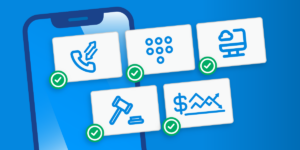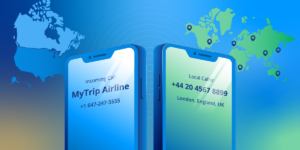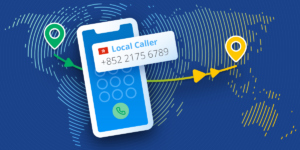Outbound Caller ID: Setup, Compliance, and Spam Tips

Simply assigning a local number to outbound calls might have worked a decade ago, but call recipients today expect clear, recognizable information. In addition, carriers are flagging suspicious patterns, so enterprises must account for differing regional rules, formats, and telecom infrastructure, all while scaling across time zones and touchpoints.
Yet many teams still struggle to strike the right balance between customization and consistency. From complying with local caller ID laws to avoiding spam flags and managing caller ID name (CNAM) displays across carriers, the challenges grow more complex with scale and geography.
Basic setup instructions exist, but often overlook critical layers like real-time caller ID automation, session initiation protocol (SIP) header control, or the strategic use of analytics to test and optimize IDs across regions.
Read on to understand what outbound caller ID really entails, how to configure it strategically, and learn some best practices that open the door to stronger customer engagement, regulatory clarity, and global voice success.
What is outbound caller ID?
Outbound caller ID refers to the phone number—and in some cases, the display name—that appears on the recipient’s screen when a business places a call. It tells the receiving party who is calling and can either encourage them to answer or prompt them to let the call go to voicemail.
For enterprises that manage high call volumes or global outreach, outbound caller ID is about showing the right number. That could mean localizing caller ID by region, customizing it by campaign, or routing calls through verified, trusted numbers to reduce spam tagging and boost engagement.
Many modern phone systems allow companies to define not only the caller ID number but also the CNAM. This is especially useful when you want your company name to appear on the recipient’s device rather than a random number (though support for CNAM displays vary by country and carrier).
Outbound vs. inbound caller ID
While outbound caller ID focuses on what the recipient sees when your business makes a call, inbound caller ID is what your team sees when someone calls into your phone system. That’s why the key difference between outbound and inbound call centers lies in visibility and control:
- Outbound caller ID affects external perception and engagement.
- Inbound caller ID drives internal routing and response.
Some systems offer integrated caller ID settings in both directions, which enables businesses to centralize management of all inbound and outbound calls under one interface.
5 benefits of outbound caller ID for global businesses
The following are five key business benefits that show why investing in customizable, dynamic caller ID capabilities pays off at scale:
1. Boost call answer rates with localized numbers
If you want to improve your call answer rates, an outbound caller ID is paramount. This is because people are more likely to answer calls from numbers they recognize or associate with their region. In fact, research shows that approximately 74% of consumers ignore calls from numbers that they don’t recognize.
Because of this, global businesses that use geographic caller ID routing to match the outbound caller ID number to the recipient’s country or area code can significantly increase their connection rates.
2. Reduce spam labeling and call blocking
Verifying and using consistent caller ID information minimizes the risk of carriers flagging your calls as spam or scams. Both carriers and call recipients look for patterns, so when they see frequent number changes, mismatched CNAM data, or missing branding, it raises immediate red flags.
By standardizing your caller ID settings and integrating with trusted SIP trunking providers, you’ll create a cleaner call reputation that supports long-term deliverability.
3. Strengthen brand recognition and credibility
Displaying your company name alongside your phone number, when carriers allow it, increases brand visibility and builds credibility. For instance, in B2B sales or customer service, a branded caller ID display reassures the recipient that the call is coming from a legitimate, recognized organization.
4. Enhance compliance with regional telephony laws
Different countries have their own rules concerning how businesses must present themselves when making outbound calls. Using dynamic caller ID customization ensures that you can adapt to local telecom regulations, whether that involves using toll-free numbers, masking numbers for privacy, or including full CNAM records.
AVOXI, for instance, operates as an outbound call center software and supports tailored configurations in over 150 countries, which gives enterprises the flexibility to stay compliant and avoid penalties.
5. Enable smarter call routing and campaign segmentation
Pairing outbound caller ID with intelligent routing lets businesses assign specific numbers to certain teams, campaigns, or regions. This supports data-driven segmentation and ensures that they use the right caller ID based on language, location, or service type. It also streamlines interactive voice response (IVR) paths and improves internal performance tracking across departments or outsourced partners.
How to configure outbound caller ID efficiently
By aligning caller ID configurations with your contact center as a service (CCaaS), unified communications as a service (UCaaS), or private branch exchange (PBX) platforms, you’ll improve call delivery and gain operational control and deeper insights across regions.
Below are four key steps and settings to help you configure your outgoing caller ID for reliability, visibility, and scale:
1. Enable dynamic number selection
Dynamic number selection allows businesses to automatically assign the most relevant outbound caller ID number based on the recipient’s location. This technique uses local presence dialing to significantly boost call answer rates and reduce the likelihood of spam tagging.
AVOXI’s TrueLocal™ feature enables this by intelligently matching outbound calls with a local or regional number from your inventory. If a sales team in the United States calls a lead in France, for example, the system will present a French caller ID automatically, without manual intervention.
To implement this, follow these steps:
- Ensure that your contact center software or PBX system supports dynamic routing logic.
- Maintain a pool of geo-matched numbers across target countries.
- Use APIs or dropdown selectors to automate number assignment based on destination.
2. Verify CNAM settings with your carrier
CNAM displays the name you’ve connected to your phone number, and it often shows your company name on the recipient’s screen. While people widely use CNAM in the U.S. and parts of Canada, other regions rely only on the numeric caller ID display.
Third-party databases or the receiving carrier maintain CNAM records rather than storing them universally. To ensure correct caller ID name presentation, do the following:
- Submit a CNAM registration request through your carrier or voice provider.
- Use a consistent, professional name (15 characters or fewer).
- Be aware that changes can take days to see and may incur one-time or monthly fees.
3. Ensure proper E.164 formatting
To ensure global deliverability and compatibility, all outbound calls should use E.164 phone number formatting. This international standard includes the following information:
- A plus sign (+)
- The country code
- The area code
- The subscriber number
For example: +1 (415) 555-2671 (U.S.) or +44 20 7183 8750 (U.K.)
Using E.164 ensures that your phone system correctly routes outbound and inbound calls through international networks. This is especially critical for cloud-based platforms that connect through SIP trunking or route via APIs.
4. Configure your SIP header
During the process of expanding into new markets, in-country regulators require documentation to ensure compliance as companies expand into their countries. Here’s what you should come prepared with when you port international numbers to a VoIP carrier:
-
The SIP header carries essential information about each call, including the originating number, display name, and authentication credentials. It determines how your caller ID information appears and whether the receiving network accepts or blocks your call.
Misconfigured headers can lead to rejected calls, incorrect caller ID display, or even security vulnerabilities. To configure SIP headers correctly, follow these steps:
- Set the “From” and “P-Asserted-Identity” fields to the desired outgoing caller ID number.
- Use encrypted transport protocols, like Transport Layer Security, to secure call data.
- Confirm your SIP provider’s accepted header format and required fields.
If you’re using a cloud platform like AVOXI, much of this happens automatically, so you’ll see consistent caller ID delivery across borders and carriers without complex manual settings.
How to avoid spam labeling with outbound caller ID
These common triggers often lead to spam or scam labeling by carriers or recipient devices:
- High call volume from a single number in a short time frame
- Inconsistent or unverified caller ID information
- A lack of proper CNAM registration
- Frequent short-duration calls or unanswered dials
- Use of toll-free or generic numbers with a poor historical reputation
- Businesses that call people who have added their numbers to do-not-call registries
- Mismatches between the caller ID name and the expected business identity
Take these steps to reduce the risk of spam labeling and ensure both carriers and recipients trust your outbound caller ID:
- Rotate numbers strategically to avoid overusing a single line, especially during high-volume campaigns.
- Monitor your call patterns and avoid aggressive dialing strategies that resemble spam behavior.
- Check call analytics regularly to identify flagged or blocked numbers early. For instance, AVOXI’s advanced call analytics helps businesses track answer rates, call outcomes, and flagged trends in real time so you can adjust your strategies accordingly.
With the right tools and awareness, businesses can avoid spam labeling while maintaining high outbound performance globally.
Best practices for global caller ID compliance
Each market has its own approach to caller ID numbers, display names, and telephony regulations, so businesses must stay informed and adaptable to remain compliant at scale. Here are three essential practices that help global organizations manage caller ID responsibly while protecting brand trust and deliverability.
Research local regulations
Start by understanding each country’s regulatory environment. Some markets, like Germany and Australia, restrict caller ID spoofing and require callers to display their registered business number. Others, like the US, enforce STIR/SHAKEN protocols to validate outgoing calls and discourage call fraud.
Maintain a consistent brand identity
Using a consistent company name and number reduces the risk of call flagging and reinforces trust. Even in regions with limited CNAM support, displaying a recognizable caller ID number builds familiarity and increases answer rates.
To maintain brand integrity, try these steps:
- Register your CNAM in every region that supports it.
- Avoid using multiple random numbers for the same region or campaign.
- Align your outbound caller ID with your digital and voice branding.
Track analytics for call performance
If answer rates drop, carriers block your numbers, or calls consistently fail, it may signal a compliance issue.
Here are some effective monitoring practices you can use to address these outcomes:
- Review flagged or blocked numbers regularly.
- Track performance by region to detect country-specific issues.
- Use analytics to inform routing decisions and caller ID settings.
Following these local caller ID best practices gives global businesses a competitive edge by delivering greater relevance, trust, and familiarity to every customer interaction.
Future considerations for outbound caller ID management
Several emerging trends are reshaping how businesses manage outbound caller ID across global markets.
- AI is influencing real-time number selection by enabling platforms to automatically choose the best-performing or locally relevant number in light of recipient behavior and call patterns.
- Greater integration with APIs and automation tools is streamlining caller ID configuration across CCaaS, UCaaS, and PBX systems.
- Cross-channel consistency, including voice, SMS, and branded communications, is becoming a priority for unified customer experiences.
Staying ahead of these trends will help businesses maintain deliverability, trust, and regulatory alignment as global voice ecosystems continue to evolve.
Your caller ID is your first impression—so make it an effective one
Outbound caller ID directly impacts whether recipients answer your calls or ignore them. The good news is that by taking control of number selection, formatting, and CNAM verification, businesses can turn that first impression into stronger engagement and improved compliance across regions.
That’s where AVOXI steps in. With tools like TrueLocal™, your team can automatically match the right number to every call, creating instant local presence and improving answer rates in over 100 countries.
Struggling with low answer rates and caller ID issues? Schedule a quick demo today to see how AVOXI’s TrueLocal™ can help your outbound calls get better answer rates everywhere you operate.
Outbound caller ID FAQs
Yes, businesses can configure outbound caller ID to display a specific phone number and, in supported regions, a CNAM. This helps them increase answer rates and brand recognition.
Related Articles
Local Caller ID Best Practices
Enhance your engagement with expert tips on Local Caller ID. Boost answer rates and build trust effectively.
Continue Reading >Local Caller ID vs. CNAM
Your guide to local caller ID vs. CNAM. Discover differences, benefits, and how they impact caller recognition and trust.
Continue Reading >What is Local Caller ID?
Your guide to local caller ID. Learn how it works and why it matters. Boost trust and response rates effectively.
Continue Reading >


